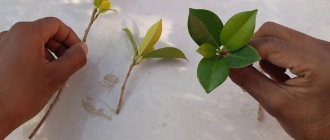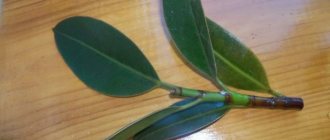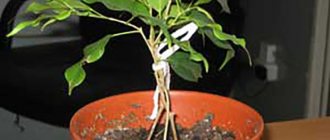Rules to help you choose a healthy shoot
If you want to independently separate a shoot from a ficus, then you need to choose only strong and healthy plants, for example, you can take a cutting when cutting the crown of an adult ficus.
However, before doing this, you need to make sure that the selected branch has leaves. The length of the process should be at least 10-15 centimeters. All actions must be performed with a sharp knife or blade. The cut must be made at an oblique angle. And under no circumstances should you use scissors, much less break a twig, as you will only injure the plant, which will result in delayed rooting and further development. If you have chosen a large-leaved species for cultivation, then in order to grow a flower at home, it is enough for the cuttings to have 3-4 leaves. In this case, it is advisable to trim the lower one, since a large number of leaves will contribute to excessive evaporation of moisture. When growing small-leaved ficus, the lower leaves also need to be trimmed, but their number can be more than 3-4.
After the procedure of trimming the leaves and the shoot itself, the plant can release white sap. If you don't wash it with water, it dries out very quickly. This cannot be allowed. Therefore, after the shoot is cut, the juice should be washed off with warm water or placed in a container with water for several hours. It is also recommended to treat the cut area with charcoal.
Before planting a ficus shoot, you need to dry it or simply change the water several times. There are two methods of planting: cuttings from roots and without them.
How to grow a ficus from a scion
The most favorable time for propagation of this type of plant is from spring to early summer. At this time, roots and leaves are intensively formed.
This tree reproduces well from cuttings. Let's consider the option of planting ficus benjamina with a shoot without roots. To do this, you can cut the stem with leaves from the top.
The cutting is placed in a jar of water and placed on a well-lit windowsill. The water must be periodically changed to clean water, you can add acetylsalicylic acid or activated carbon to avoid rotting. Leaves should remain dry. After some time, the shoot will take root.
There is another way to plant ficus benjamina cuttings. Instead of a jar of water, you can use wet sand. After cutting, the cutting should be washed to remove milky juice and slightly dried. A large twig may not be accepted due to excessive evaporation of moisture. After the roots appear, the finished seedling should be planted in a pot.
Another option is to plant ficus benjamina with a shoot without roots directly into a container. This can be done after processing the cut. In this case, it is necessary to create all the optimal conditions for the development of the flower: proper lighting, temperature and humidity.
Let's consider what should be done next with the cutting to grow Ficus Benjamin, and how to plant a twig that has taken root in a pot.
Preparatory procedures
Flower growers and lovers of home crops choose ficus plants due to the fact that this flower is completely unpretentious in care and does not require specific conditions. Before planting a ficus, preparatory procedures are carried out that are of great importance for the success of the operation. Planting a ficus developing from a shoot is considered safe and easy to perform. At the initial stage, you will need a clean, sharp tool, such as a knife or blade, or an open vessel with warm water.
The selected shoot must have one or more viable buds and leaves, which is the key to successful completion of the procedure. Seating is carried out preferably in the spring and summer, since conditions at these times of the year are most favorable. A cutting is cut from an adult and completely healthy bush. It is important to know that its size should not exceed 15 cm. The cut is made at an acute angle.
Important ! Making a cut with scissors or trying to carefully break the shoot will lead to a long recovery of the flower, as well as slow rooting of the new plant.
The cut shoot is placed in a container with water for 1.5-2 hours. After this, the sections are sprinkled with charcoal powder or treated with special antiseptics.
In addition to installing the cuttings in water, the following method is also practiced. The small tops of a flower, for example, ficus benjamina, are wrapped at the base in cotton swabs soaked in water and a mixture of fertilizers. These structures are installed in a saucer with a small layer of water. The cutting can remain in this position for a long time until the first roots appear. Next, it is strengthened in a pot.
Choosing a pot
It is very important what kind of pot the plant will be planted in, because how well the ficus will feel depends on its size, material and shape. Since ficus is heat-loving and does not tolerate overcooling of the soil, it is best to choose a container made of plastic or clay for it. In ceramic and glass pots, the plant will freeze. Plastic pots do not always look aesthetically attractive. However, this problem can be easily solved with the help of a flower pot, which can also be changed at will, choosing a suitable decoration for the surrounding interior. The shape of the pot is also important: it must be deep and high enough, so that at least 2 cm remains from the tips of the roots to the drainage laid at the bottom. A shallow and wide pot will not be suitable, since the roots of the plant will grow in depth. The size of the first pot for ficus should be very small. In a container that is too large, it will be uncomfortable, which will slow down its growth.
When choosing a pot by size, you can be guided by the following criteria:
- take a pot whose diameter does not exceed 10 cm;
- select a pot individually for the plant, measuring the distance from the roots to the walls - it should be 2.5 cm;
- measure the width of the root system and choose a pot that is 2–3 cm in diameter larger than the width of the roots.
In addition, the pot must have holes at the bottom to drain excess water. If there are none, you need to do them yourself. Using a container without holes is unacceptable, as moisture will accumulate at the bottom, causing the soil to become waterlogged, and the roots will begin to rot due to stagnant water.
Important! The soil should be neutral or slightly acidic, with a pH level from 5.5 to 7.
Soil for planting
In order for the prepared ficus shoot to take root well, you need suitable soil for the ficus, which you can purchase in the store or prepare yourself:
- it is necessary to take peat, perlite and vermiculite in equal parts;
- mix well;
- add river sand without admixture of clay in a ratio of 1:3;
- prepare drainage; for this purpose you can use expanded clay or pebbles.
The main requirement for the soil is that it should not be heavy and greasy; ficus prefers loose, nitrogen-rich soil.
Rooting
In order for the ficus shoot to produce roots, it is placed in water or in the ground. If you choose the first option, then to improve the conditions under which roots appear, nutritional supplements that stimulate growth are added to the water.
For planting, choose a small container and immerse a smaller part of the shoot in it. Experienced gardeners recommend applying a small amount of honey to the submerged area.
To avoid rotting of the submerged shoot, dissolve 1 tablet of activated carbon in water.
When choosing to grow roots in an earthen environment, first also keep the cutting in a container of water for several hours.
The pot where the cutting will be planted is chosen to be small, with a good drainage system and holes for air circulation. As the root system grows and the overall growth of the flower, transplants are carried out to increase the volume of the pot.
The mixture can be purchased at a specialty store. Many gardeners prepare it themselves.
The following components are usually used:
- Peat;
- Sand;
- Perlite;
- Vermiculite;
- Expanded clay.
This composition guarantees moisture capacity and good aeration of the root system. Perlite is poured into the pot where the cutting will be planted, and then soil is added. Select a slightly damp mixture. Then a recess is made, the depth of which varies depending on the length of the cutting. The shoot is strengthened to the level of the first leaf on it.
Ficus should be planted in moist soil. The shoot is placed on the ground and covered with earth. In some cases it is necessary to install a support.
Planting ficus trees does not seem to be a complicated procedure, but neglect and carelessness should not be tolerated.
How to root a shoot correctly
The cutting should be planted immediately after it is separated from the adult plant. To do this, you need to prepare a mini-greenhouse, which should have good lighting, and also purchase some fertilizer. Plant the stem in the prepared soil, then cover it with a glass jar or cut plastic bottle. During the rooting period, the plant must be looked after. Care consists of regular watering and ventilation of the plant. Within 2-3 weeks the first leaf will appear, which is direct evidence that the cutting has taken root. Then you don’t have to replant it.
Ficus rooting technology
Strong, healthy, developed roots are the key to active and successful growth of the plant, so you can plant only those sprouts that are already well rooted.
You can carry out the procedure as follows:
- Washed, soaked for a couple of hours in water, after which the dried and charcoal-treated cuttings should be placed in a small container with water for rooting.
- The water must be purified and always warm. It should be warmer than room temperature, but not hot.
- The container in which the shoot or leaf will take root should be dark and opaque.
- Place the cutting in water so that the lower leaves do not touch the water.
- Observe temperature (+25–30°) and light conditions. The more bright diffused light available to the shoot, the faster it will take root.
- Create a greenhouse effect. To do this, use a plastic bag placed on top of the container with the sprout. The package should not restrict the leaves. There should be a gap of a couple of centimeters between the top of the cutting and the bag. Or use a clear plastic cut-off bottle. Additionally, make small holes in the bottle for oxygen access.
Important! High temperature (up to +30°) and high humidity are necessary conditions for the successful and rapid rooting of any ficus cuttings.
Rooting in water is the easiest and most effective way. You can also root cuttings in the ground. In this case, the procedure is carried out similarly, only instead of a glass of water, a glass with a nutrient substrate is needed, into which the shoots or leaves are immersed, watered generously and a miniature greenhouse is created.
Regardless of the rooting method, this process takes from 2 to 5 weeks. The rate of formation of the root system depends on the type of cuttings (shoot or leaf), temperature, treatment with growth stimulants and the amount of lighting.
Ficus propagation by apical cuttings
This is a fairly proven and most popular method of reproduction. You need to select the shoot that you will use for propagation. It should be well developed and without signs of disease.
To make a good cut, you may need special tools. This could be a sharp knife or pruning shears. The instrument must be disinfected. Otherwise, you can introduce an infection both to the main plant and to the shoot for cuttings.
The cut should be made at 45 degrees. The length of the shoot can be twenty centimeters, but not less than ten. It all depends on the presence of dormant buds on the cutting and at what distance they are located. Both the main shoot of the ficus and the side shoot are suitable for cuttings. Especially if your ficus has grown and with formative pruning, you get several shoots that can be used for propagation.
Inspect the cutting to ensure that its bark is intact and without signs of damage. If desired, you can shorten the stalk or divide it into several parts.
Next, we take a container of water, it should be at room temperature, and we place our cuttings in it. We change the water in a glass or jar regularly, this will not allow it to stagnate. To prevent the cuttings from rotting, crushed tablets (activated carbon) can be added to the water. The container for cuttings (if it is a jar) must be wrapped in something dark, or use a dark container.
This is necessary so that the water does not begin to bloom in bright light. If you get very short cuttings. Then they can be fixed at the edge of the container. You can use a circle made of paper or cardboard. Be sure to tear off the lower leaves of the cuttings, and generally try to ensure that the remaining leaves do not touch the water. Only the lower part of the shoot/cutting should be in the water.
Place the container with the cuttings in a warm and bright place. The cuttings should not be exposed to direct sun, but the area should be well lit. If moisture begins to evaporate in your container. Water can be added to the desired level. Or replace it completely.
You can use cuttings for propagation directly into the ground. To do this, we simply take a container in which we will root our cuttings. We use a mixture of peat and sand, for better rooting, the ends of the cuttings can be treated with root formation stimulants.
We simply stick the cuttings into the prepared soil. But in this case, you will need to use a greenhouse. It can be made from a plastic bag or plastic bottle. This is necessary in order to maintain constant humidity.
Ficus trees do not take root quickly, so be prepared to wait a few weeks. If you used a container with water, then you can determine whether there are roots on the cuttings by simply inspecting the cuttings. When roots appear, we take the cuttings and plant them in a permanent place, in the required pot size. But when using ficus cuttings and its rooting in the soil, here we look at the appearance of new leaves on the cuttings.
As soon as new leaves appear, the cuttings can be replanted. But my advice is this: use a separate pot for each cutting, or use peat pots. This is necessary so that when transplanting to a permanent place, you minimally injure the young roots. Than if you planted several cuttings in one pot.
Growing ficus from leaves
Ficus can be grown at home from a leaf:
- 1. Cut a leaf from the central shoot along with the cuttings.
- 2. The cut is washed with running cold water.
- 3. The sheet is dried for two hours at room temperature.
- 4. The sheet is rolled into a tube and secured with a loose rubber band.
- 5. Then a thin wooden stick is threaded through the center of the tube, which will serve as a support.
- 6. The leaf is planted in the ground, deepening the cuttings by 2 cm.
- 7. The seedling is watered.
The pot with the seedling should be kept away from heating devices and sunlight. After about a month, the young ficus will produce roots.
Representatives
If we talk about well-known representatives of the family, then most often they grow:
- Ficus benjamina. A favorite of all gardeners. An unpretentious decorative leaf plant. In the natural environment it can grow up to 8 m, at home - up to 2 m with impeccable care. The leaves of the bush are small - light, dark green or variegated, depending on the variety. Characterized by rapid growth.
- Rubber-bearing (Ficus Elastica). Ficus with dense, fleshy leaves. Almost all varieties of rubber ficus are poisonous to one degree or another. Therefore, they can only be kept in areas that children and pets do not have access to. The viscous white juice that is released on the cut is especially dangerous. Before planting rubber-bearing ficus from cuttings (by any other vegetative method), it is better to arm yourself with gloves to protect the skin of your hands. During all manipulations with the plant, you must not touch yourself or others on areas of the body unprotected by clothing, or rub your eyes.
- Bengal. Broad-leaved three-meter bush. Often found in offices/hospitals.
- Dwarf ficus. Creeping ground cover plant. At home it is grown as an ampel plant, most often variegated varieties.
Planting ficus seeds
Ficus seeds are sold in specialized flower shops. It is necessary to select undamaged material. The grains are pre-soaked for 2 hours in water at room temperature. Then they are transferred to a growth stimulator mixture for 24 hours The drugs “Gumat” and “Epin” are suitable for this procedure. The use of stimulants helps combat various diseases. It is better to use several pots for planting. Seeds are planted in the ground, one per container.
The immersion of grains should not exceed 0.5 centimeters. They should not be planted too deep, as there is a risk of the seeds rotting in the soil. Planting material is sprinkled with sand or purchased substrate.
The flower grows best in breathable soils. A mixture of coarse sand, deciduous soil and peat works well.
After planting, the soil should not be watered , as the seeds can be washed away with a powerful stream of water.
Tip: It is better to use a spray bottle.
The water should not be ice cold or too hot.
After planting, using a plastic bottle or glass jar . In such conditions, the future plant will quickly grow and take root.
After germination, the ficus must be gradually accustomed to room temperature. When active growth reaches more than 5 centimeters in length , the plant is planted in separate pots.
It will be useful for flower growers to learn other information about ficuses:
- Why do Ficus leaves turn yellow, blacken and fall off and what to do in this case?
- The benefits and harms of ficus, poisonous or not?
- Features of ficus transplantation at home.
Important! The soil must be ventilated every two days, since under constant greenhouse conditions and lack of oxygen, seed rotting can occur.
You can learn more about propagating ficus at home in this material.
Basic rules for planting plants
You can use a purchased seedling or propagate vegetatively. The sequence of actions remains almost unchanged. Depending on the species and variety, there may be slight differences in the procedure.
In order for planting a ficus at home to be successful, several conditions must be met:
- choose the right pot size, wash and disinfect the container;
- purchase a ready-made soil mixture or create a nutritious, light, well-drained substrate from available materials;
- make warm water for irrigation, after leaving it to settle for a day;
- prepare a transparent bag or glass jar to create greenhouse conditions;
- strictly follow agrotechnical recommendations.
Preparing the substrate and pot
When planting ficus at home, the main importance is the correct choice of container and soil. The size of the pot during transfer depends on the parameters of the earthen ball. For young seedlings and seedlings, you need to take a small flower pot, the roots should not touch the walls and drainage layer, but should be located 2-4 cm further.
Choose a shape that is wide enough, but not flat. The material of the container for young ficus is plastic; for an adult it is advisable to use unpainted ceramics.
The substrate can be purchased ready-made or collected from turf and deciduous soil, river sand, peat in a ratio of 2:2:1:1. To reduce the risk of root rotting, add a small amount of charcoal or ash. Add vermicompost as a nutritional component. Before use, it is recommended to pour natural materials with boiling water or a solution of potassium permanganate for disinfection, and calcine the sand in the oven.
Procedure technology
The recommended time for the operation is spring, so that by the time it gets cold, the plant has time to get used to the changed microclimate. In autumn and winter, it is permissible to replant to a new location only if the integrity of the container is damaged, an unpleasant, musty odor appears from the soil, the root system is colonized by pests, or diseases develop. It is important to plant the ficus correctly in a flower pot.
Place a drainage layer of expanded clay 2 cm high at the bottom. Next, add the prepared soil mixture; for a young seedling, fill the container almost completely. Make a small hole, carefully place it so that the roots do not bend, sprinkle with substrate. After planting, water thoroughly, removing excess liquid from the pan after 10-15 minutes. To create greenhouse conditions, cover with a transparent bag for a week. Adult specimens do not need this.
Transshipment method
Prepare the container and nutrient soil in the same way. Place drainage and 3-4 cm of fresh soil at the bottom. A plant in an old container can be lightly watered in advance and tapped on the side surfaces so that the earthen lump moves away from the walls of the pot. Turn upside down, gently twisting the container and holding the houseplant. Remove the tree, then the ficus can be planted in a pot. Fill the space between the earthen ball and the walls with nutritious soil mixture.
The importance of replanting after purchase
Having brought a plant from the store, you must immediately put the flower in a permanent place. You cannot touch it for about 2 weeks, creating the necessary microclimate. The bush may shed some of its foliage; this is a physiological process of adaptation to changed indoor conditions; there is no need to worry. In a home environment, the crop must be grown correctly, since the plant can lose its decorative effect or die. After purchase, replanting is necessary because the store-bought substrate contains chemical additives to maintain its presentation and is not suitable for long-term use.
About 2 weeks should pass before the procedure. The pot should be selected according to the size of the root system; most likely you will need a little more than what you had when purchasing. It is not necessary to use the transshipment method; on the contrary, it is advisable to replace most of the soil mixture. There is no need to rinse, nor do you need to try to remove absolutely all the soil. Further, the process is similar to replanting with a complete replacement of the soil. It is recommended to use a light nutrient substrate with a neutral reaction.
Ficus is often grown at home. The culture is fast growing and requires periodic replanting. Proper planting is the key to successful plant cultivation. The tree is demanding of environmental conditions, but complex care is not needed. It is enough to follow general agrotechnical recommendations.
How to transplant a ficus at home without mistakes
To minimize the number of errors when replanting a ficus, you need to:
- Select the correct primer based on the composition of its components.
- Choose a good and correct pot.
- Lay a drainage layer.
- Choose the right time for the transplant.
On a note! A common mistake made by inexperienced gardeners is improper preparation of the plant or excessive pruning of the root system.
You should never replant a ficus in winter, as this can destroy the plant. The remaining options for the procedure are acceptable for the plant. The main thing is to choose the right container and substrate.
Care after landing
Since it is recommended to plant in spring or summer - during a period of very high average daily temperatures, watering plays an important role, which is carried out 2 times a week.
Excessive watering leads to rotting, so it is important to carefully monitor the volume of liquid applied. The location of the pot with the young cuttings is also of great importance. The young flower is harmed by drafts, and is benefited by humidity and sunlight. At the same time, direct sunlight is detrimental to a young plant. To avoid drying out, create diffused lighting.
Since planting a ficus with a shoot is not difficult, the emphasis is on care after rooting. In some cases, a greenhouse is organized. To do this, the top of the container is covered with cellophane or a plastic container, which allows you to maintain a constant temperature and humidity inside the system.
The temperature and quality of the water used for irrigation play an important role. Experienced gardeners recommend soft warm water. Usually the water coming out of the tap is hard. To soften it, boil it or leave it for 24 hours.
The average temperature at which all vital processes in a flower proceed at a good pace and development progresses according to schedule: + 25 °C.
It takes from 2 to 4 weeks before the first roots appear. This method is convenient for propagating ficus at home.
Landing
How to plant ficus benjamina with a shoot and roots? The first thing to do is choose a suitable pot. The material from which it is made is not important. It can be plastic, clay, ceramics or wood. The main thing is to avoid chemical exposure to the plant.
When choosing a container, you should take into account the condition of the roots and the size of the ficus. In addition, the pot must be provided with a good drainage system. Ideally, the container will be of a size such that the roots will not reach its walls by about two centimeters.
How to plant ficus benjamina with roots? Place drainage at the bottom of the container. The soil should be used specially for ficuses; it should have a loose structure. We plant a cutting in it. After planting, it is recommended to create a greenhouse effect by covering the ficus with a glass cup, jar or plastic wrap. This will help maintain the correct temperature and humidity.
The rooting process lasts about twenty days. Then the plant begins to stretch upward. But do not rush to clean the greenhouse; it is recommended to first wait until at least one new leaf appears. Periodically, you need to remove the greenhouse for a while so that the young plant gets used to indoor conditions. And only then can the greenhouse be removed completely.
Now we know how to properly plant Ficus Benjamin in a pot. Does it need to be replanted in the future? Let's find out further.
Description and properties of Benjamin
Ficus benjamina has erect shoots and a round stem. Its leaves are oval in shape with a pointed apex.
Ficus benjamina is a tree with a wide crown. Its trunk is gray in color with brown spots. In the wild it reaches about 25 centimeters in height.
Ficus benjamina has a beneficial property. It purifies and improves indoor air quality due to its ability to absorb certain harmful substances.
Allergy sufferers are advised to be careful with this plant. The danger for them is the milky sap of the plant.
Tincture of ficus benjamina leaves has medicinal properties against certain diseases, such as osteochondrosis, radiculitis and arthritis.
There are many folk signs associated with ficus. He is a symbol of love. It is believed that a young family with a ficus growing will be strong and friendly. If a woman starts a young tree at home, she will soon have a child.
Basic methods of reproduction
At home, ficus benjamina can be propagated using several methods. Depending on the purpose of the operation, several young plants can be obtained simultaneously.
The culture reproduces easily, the survival rate is high. It is important to properly care for planting material, prepare the soil, and create an optimal microclimate.
Leaf propagation is almost never used for this variety; the method is justified for the rubber-bearing species.
At home, propagation of Ficus Benjamin is carried out using:
- cuttings;
- rooting of cuttings;
- planting seed material.
Regardless of the chosen method, rooting a part of the plant and germinating seeds can be carried out in a mixture of a special substrate for palms and ficuses with sand or in soil prepared from improvised means. In any case, the result should be a light, drained mass. In heavy soil, planting material forms a root system and develops more slowly and can rot.
It is recommended to use expanded clay or pebbles for drainage. Rooting and germination can be carried out in a common container, so that later they can be planted in individual pots.
Before planting, natural materials and containers should be disinfected with a solution of potassium permanganate, boiling water, calcination (sand) or hot steam (earth).
Propagation by cuttings
You can use cuttings from the middle of the shoot or the top. In order to separate the cutting from the main stem, it is better to use a sharp blade. It is pre-sterilized.
You can cut any length of the cutting, but the presence of an internode is a prerequisite. Without this, a new leaf cannot appear. The optimal size of a ficus cutting varies from 11 to 15 cm. It can have from 5 to 7 leaves. The cutting can take root in water or in the ground.
A shoot with a ready-made root system
Reproduction process in water:
- Thoroughly wash the edge of the stem to remove the milky juice under running cool water. This sap can prevent the ficus from rooting quickly.
- Dip the tip of the cutting into a bottle of warm, clean water. The leaves should not touch the water.
- In this position, the cutting should remain in a sunny place for 2-3 weeks.
- When the first roots appear, the plant is transplanted into prepared soil. Water lightly.
After 3 weeks the first sprout will be visible. The shoot being prepared for planting can be placed in a tall pot with a thin neck.
Rooting cuttings in the ground:
- As in the previous case, thoroughly wash the cut to remove milky juice under running water.
- Allow the edge to dry for 30-40 minutes.
- Several holes are made in a plastic cup.
- Planted and covered with soil up to the beginning of the neck. To speed up rooting, you can plant the sprout in purchased soil - a soil mixture.
- No need to water. Cover the top with a plastic bag.
The first leaves will appear within 3-4 weeks after planting.
Interesting to know! If propagation was carried out in the spring, then at the end of summer you can transplant the plant into a larger pot.
Reproduction by air layering
This method is similar to cuttings and can be considered one of its varieties . Its peculiarity is that the cuttings are rooted on the plant itself . Thus, the stages of cutting cuttings, processing them and choosing a rooting method are eliminated. The algorithm for propagating Ficus Benjamin by layering is extremely simple, but it must be done correctly:
- We select a lignified apical shoot, measuring no more than half a meter from its top, and mark the place of “rooting”.
- On the selected area of the shoot, we cut off the leaves and make a circular cut of the bark without touching the wood.
- The cut site is treated with any root growth stimulator.
- The treated cut is covered with damp moss. A plastic film is placed on top of the moss, strengthened with tape or braid. Both the moss and the film should fit loosely around the shoot: roots will develop under them.
- After 1-2 months, roots will appear at the cut site. The plant is separated from the mother plant. It can be planted in a separate container in a permanent place.
Defrosting ficus benjamina with a leaf
Ficus benjamina can be grown from a single leaf. To do this, you need to cut off the leaf with a small section of the shoot, capturing the area just above and below the place where the leaf is attached. You can cut off the shoot and cut several “blanks” for propagation.
A section of shoot or leaf cutting is cut out with a sharp knife and freed from milky juice. After allowing the cuts to dry, the cuttings are rooted into the resulting mixture of soil so that parts of the shoot are in the soil, and the leaf itself is on its surface.
If the sheet is large, then it is rolled into a tube, which is secured with an elastic band. For better fixation, a small wooden peg is placed in the center of the rolled leaf. The rooted leaf is covered with a plastic bag to create greenhouse conditions.
Caring for it will consist of regular daily ventilation and moistening the soil. After about a month, new shoots will appear and young ficuses can be planted in separate pots.
As you can see, propagating Ficus Benjamin vegetatively is quite simple. The grower even has the opportunity to choose a method. The result will not be long in coming; young ficus trees grow very quickly, becoming a real decoration of the interior.
Propagation by cuttings
Unlike rubber ficus, ficus benjamina propagates only by cuttings . The most favorable time for this is all spring and summer in the first half. At this time, active formation of roots and leaves occurs.
For rooting, it is necessary to take the tops of the shoots. It is easier to get a slender tree from them. The middle part of the branches is also well suited for propagation by cuttings. In this case, buds begin to develop in the axils of the leaves, and the cutting begins to branch. If you plant several rooted cuttings in a container, then after some time you can get a beautiful lush bush.
Which cuttings are suitable
And, under no circumstances, do not cut long cuttings. They have a lot of leaves, so the moisture evaporates too intensely, and the cuttings without roots will wither very quickly.
There should be from 3 to 4 nodes on the cutting (this is the place on the shoot from where the leaf grows). Cuttings on cuttings must be slightly dried (this will reduce the possibility of rotting), and then placed in water or in a substrate. Rooting of cuttings must be done in warmth and light, in a room where there is no direct rays of the sun.
In water
Most indoor pets easily take root in water. For this purpose, well-settled tap water is recommended. If the cutting feels good in a container with water and does not rot, then it should not be changed. You can only add fresh water.
When the roots on the cuttings have developed well, they must be planted in a pot with soil substrate and watered well. The second watering should be done only when the soil in the pot dries well.
Watering
When watering Ficus Benjamin, it is not recommended to set a strict schedule. It is necessary to take into account the age of the plant, lighting, air humidity, temperature, and time of year. So, in the summer, watering should be moderate.
Before each watering, the soil should dry to a depth of 2-3 cm. When watering, the water should pass through the drainage hole into the pan, then excess water can be drained. In winter, the plant does not need intensive watering; it is enough to water the ficus properly if necessary.
Water for irrigation should be settled or boiled (cooled to room temperature). It is recommended to add liquid mineral fertilizers to the water. It is worth noting that Ficus Benjamin loves warm showers every 2-3 weeks.
To do this, the plant is placed in a bath, the soil layer is covered with polyethylene and gently doused with a warm stream of water.
After this procedure, to avoid hypothermia, you should leave the ficus in the bathroom for a while.
Peculiarities of reproduction depending on the type of flower
The variety of ficus trees can amaze the imagination. But this can also create a number of problems for those who dream of creating their own garden in an apartment or country house. After all, each plant requires an individual approach and has its own characteristics.
Flower growers use many methods to propagate plants.
The most popular among them:
- cuttings;
- using air layering;
- leaf rooting.
The method is selected depending on the type and age of the mother tree.
How to plant a broadleaf ficus shoot?
For propagation of broad-leaved ficus species, the best method is cuttings and leaf planting.
This is interesting: Pot size for violets: what is the optimal volume and diameter of the pot
But the easiest way is to plant an adult plant when transplanting:
- A day before moving the ficus to a new pot, it must be watered properly.
- Having rolled out the root ball of an adult plant, carefully examine the sprouts that have already taken root.
- Carefully separate them from the main root, trying to damage as little as possible.
- Plant a new plant in a container with nutrient soil prepared for it.
- Water with a solution containing additives that facilitate rooting.
- Cover with a glass jar or polyethylene, creating greenhouse conditions.
- Water daily and ventilate for 30 minutes.
Important! Both the mother plant and the new ficus need special care after transplantation; do not touch a young (up to 3 years old) tree or a weakened plant.
Without replanting, you can get a new flower by rooting cuttings. To do this, pinch off the top of the ficus - a cutting 10 to 15 cm long, preferably already semi-lignified, and treat the cut site with a disinfectant compound. The shoot is placed in a nutrient solution until roots appear, then planted in the ground.
Some gardeners take cuttings from the middle of the trunk, but they must have at least 3 leaves. The cuttings are also kept in a nutrient solution until roots appear or planted immediately in prepared soil, watered abundantly, the leaves are carefully rolled into a tube or cut in half, which helps reduce moisture consumption and increases the chances of the rapid appearance of new roots.
If everything is done correctly, after a month young leaves will appear on the new tree.
Reproduction of Ficus Benjamin
Ficus benjamina is best propagated by cuttings, both apical and stem. Cuttings are carried out in the spring or summer months.
Important! For propagation, branches are selected with a stem that is already woody, but retains flexibility; the green shoot will not be able to produce a root and will rot.
It is not recommended to cut cuttings longer than 15 cm; it is best to combine the preparation of cuttings with the procedure of pruning the mother plant. Before rooting, we must not forget to remove the milky juice from the cuts. For this species, the method of propagation by air layering is rarely used.
Reproduction of ficus benjamina photo
When pruning in spring, there are always a lot of apical shoots left, which can be used as planting material. Ficus benjamina needs regular pruning to shape its crown. Cuttings can be rooted in water and in soil with equal success; this variety of ficus quickly takes root.
How to breed the Bengal species?
One of the most interesting species, in nature one tree can seem like an entire forest. And all thanks to aerial roots that appear on long branches, descend to the ground and sprout, turning into strong trunks. Flower growers, taking advantage of this feature, create compositions from aerial roots in the form of openwork patterns, braids, and lattices.
Ficus Bengal can be bred at home, propagating not only with the help of aerial roots sprouted in the soil, but also with cuttings and seeds - after flowering, berry-like fruits appear on it, which birds feed on. Flowering of these ficuses is a frequent occurrence, so getting seeds is quite possible.
- Seeds are sown in light peat soil in small containers with sides about 5 cm in height.
- Sprinkle sand and peat soil on top (layer no more than 1 cm).
- Well moisturizes.
- Cover the container with glass or transparent film.
- Ventilate and water every 3-4 days.
- Seedlings take up to 2 months to germinate.
- The container with the sprouts is placed in a bright, warm place, they wait for the first leaves to appear, and then, 3-4 months after the sprouts appear, they are transplanted into pots.
A labor-intensive process that requires constant attention is fascinating for true connoisseurs who observe the process of tree growth from the first moments of its appearance.
This species is also propagated by cuttings, germinating layering from lignified lateral and apical shoots.
Breeding and planting large-leaved ficus
Among the ficuses there are specimens that are striking in the size of their leaves. Some plates grow up to half a meter in length; lyre-shaped ones surprise with carved edges and veins, the pattern of which makes them look like this musical instrument.
Large-leaved ficus can be propagated by seeds, although this is perhaps the most exotic and difficult method. Most often by layering - cuttings that are germinated and rooted, or by roots on an aerial stem devoid of bark, or planted with leaves.
- A large leaf with a stalk on which there is a bud is cut with a sharp instrument.
- Wash off the juice with warm water.
- Place in a bowl with Kornevin or another nutrient mixture.
- Cover with glass or film, making a “mini-greenhouse”.
- Germinate for a month.
After thin, fragile roots appear, the plant is planted in a small pot filled with drainage and a mixture of peat, sand and a small amount of garden soil. The plant is covered with a glass jar. Moisten the soil, shading and making sure that the temperature is constant and not lower than 23 degrees, wait 3 months. When the ficus begins to grow and the first leaves appear on it, it can be planted in a larger container.
Important! Good saturation of the earth with oxygen is required, so the containers must have holes. Not only at the bottom, but also on the sides.
When planting a leaf with a cutting in the soil, it is not recommended to bury the plant: if the growth point is under a layer of soil, the ficus will die. Neutral light soil, warmth, constant gentle moisture and watering with root growth activators give good results.
Ficus rubber breeding
Rubber-bearing ficus is the most common one for indoor growing. It attracts gardeners with its large, dense leaves and is considered a symbol of well-being. This group of ficuses is best propagated by cuttings.
You can use apical shoots, as well as fragments of a stem with a leaf. You can root cuttings both in water and in soil using a mini greenhouse.
Ficus rubber propagation photo
Despite popular belief that large-leaved varieties can be propagated by leaf, this is not actually the case. By placing a leaf in water, roots may appear on the petiole, but when transplanted to a separate pot, there will be no shoots. The leaf will sit in one place, forming a root system.
Aged plants can be propagated by air layering; this will rejuvenate the ficus and produce several young shoots.
Top dressing
Rapid growth in plants begins in early spring and continues until mid-autumn. At this time, the ficus is fertilized every 15-17 days. You need to alternate mineral and complex supplements. Thus, in a month the flower will receive both one and the other. Flower shops have a huge selection of organic fertilizers for ficus.
You can only water the soil with various types of additives; contact with the foliage is prohibited. Such mixtures can leave burns on the outside of the leaf.
It is not recommended to feed only transplanted or new flowers. The soil contains a sufficient amount of microelements; oversaturation will only do harm.
Young flowers, during the period of their active growth, are fed with fertilizers with a high nitrogen content. It promotes greening and color saturation.
Preparing for winter
Ficus is a tropical plant that is accustomed to warm, even hot climates. The harsh winters of Russia are difficult for them to endure. Care during the colder months of the year should be different.
During the heating period, the humidity in the room decreases, this can adversely affect the general condition of the ficus. To increase the humidity in the room with the plant, install a portable humidifier. His work will be useful not only for ficus, but also for humans.
Freezing is a common problem for gardeners in winter. Any flowers should be removed from the floor and moved to insulated window sills.
Ficus on the windowsill
If the tree is tall, then the pot itself with soil is insulated. To do this, you can put newspapers, magazines, and foam. The goal is to protect the roots from freezing.
Draft is another cause of plant death. The slightest stream of cold air can have a detrimental effect on the ficus.
It is worth paying attention so that the leaves do not touch cold surfaces or glass windows. The consequence will be curling of the leaf, rot and death of the entire flower.
Useful tips
Some tips from experienced ficus growers:
- to stimulate root formation, several shallow scratches should be made on the lower part of the cutting;
- aloe juice can be used as a root growth stimulator by treating the cuttings with it before rooting;
- Irrigation with settled tap water should be alternated with irrigation with rainwater, thereby preventing soil salinization;
- it is convenient and useful to combine watering with fertilizing;
- The leaves of the plant must be regularly wiped with a dry cloth.
Sources
- https://FB.ru/article/276465/kak-posadit-fikus-otrostkom-poshagovaya-instruktsiya
- https://MoiOrhidei.ru/fikus/kak-posadit-fikus
- https://fermer.blog/bok/komnatnye-rasteniya/dekorativno-listvennye/derevya/fikus/uhod-za-fikusom/1793-kak-posadit-fikus-v-domashnih-uslovijah.html
- https://vsecveti.life/komnatnye-tsvety/fikus/fikus-ne-daet-korni-v-vode.html
- https://kachestvolife.club/rasteniya/kak-posadit-fikus-v-domashnih-usloviyah-otrostkom-listom
- https://selo.guru/rastenievodstvo/dekorativnolistvennye/derevjya/fikus/uhod-f/posadka-fik.html
- https://SamMedic.ru/447074a-kak-posadit-fikus-bendjamina-otrostkom-bez-korney
- https://cvetokmir.ru/kak-posadit-fikus-bendzhamina-otrostkom.html
- https://pocvetam.ru/komnatnye-rasteniya/fikus-uhod-v-domasnih-usloviah.html
- https://naogorode.net/kak-razmnozhit-fikus/
[collapse]











